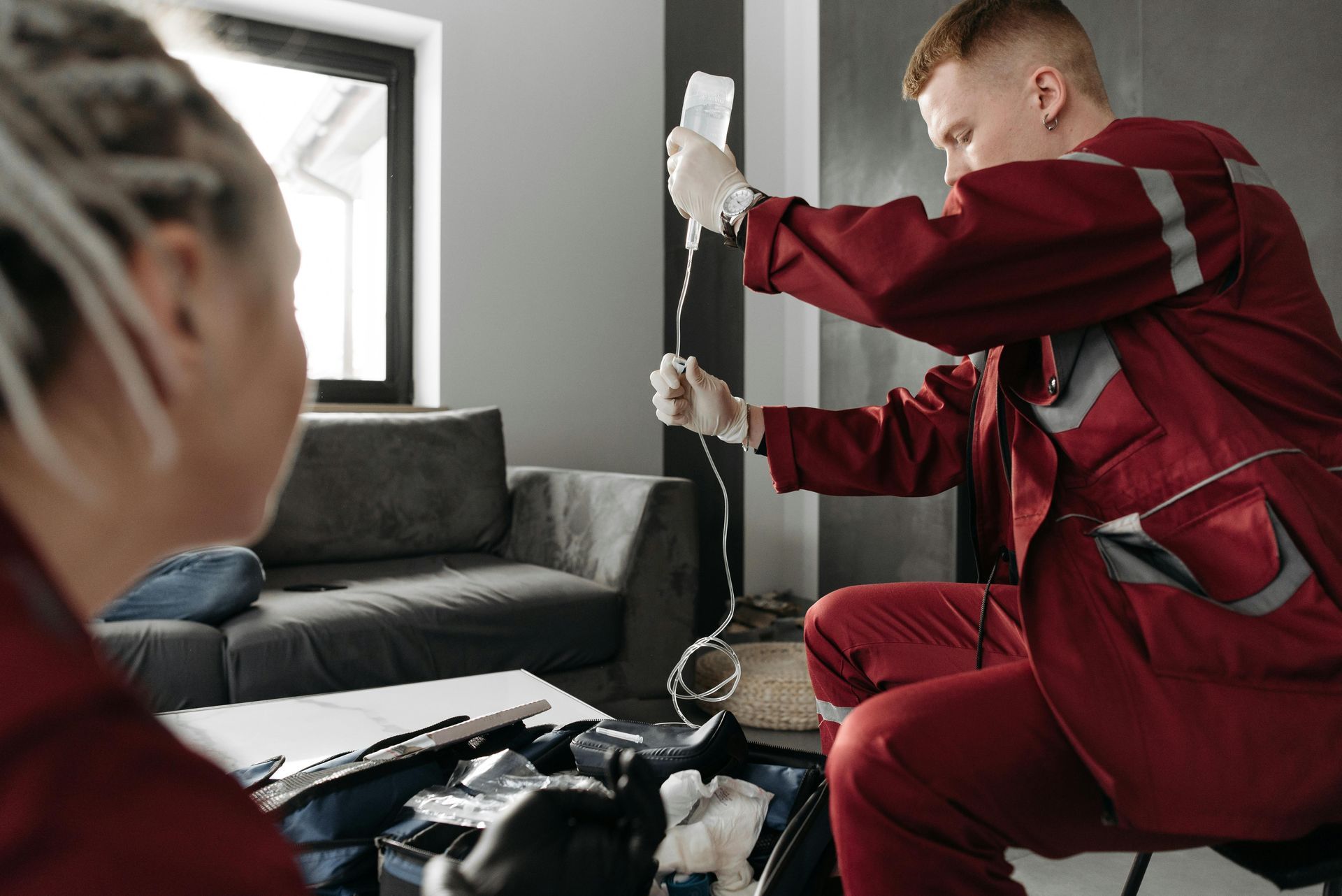Vitamin IV Therapy Side Effects and How to Minimize Them
Vitamin IV therapy has gained popularity as a quick and effective way to boost energy, immunity, and overall wellness. Unlike oral vitamins, which must pass through the digestive system, IV therapy delivers nutrients directly into the bloodstream.
While IV vitamin therapy is generally safe when administered correctly, all medical interventions carry risks. This guide breaks down the common but mild side effects you may encounter and highlights the serious risks you should be aware of. Most importantly, it gives you an action plan for staying safe and minimizing adverse events.
Common and Mild Vitamin Therapy Side Effects
Most people tolerate vitamin IV vitamin therapy well, but some mild side effects may occur:
Infusion Site Discomfort
This is the most common complaint and typically occurs immediately during or shortly after the IV therapy. You might notice mild pain, temporary bruising, or slight swelling at the IV site (usually the inner elbow or wrist).
This is either a normal vascular reaction to the puncture or a slight infiltration. Meaning some of the intravenous fluid leaked into the surrounding soft tissue. This usually resolves on its own within hours or a day.
Flushed or Cool Sensation
During the vitamin infusion, you might experience an odd, cool feeling spreading up your arm. Sometimes you may feel a sudden, intense warmth or flushing in your chest or face. Some people also report a temporary, metallic taste in their mouth.
This is often triggered by the abrupt introduction of specific high-dose ingredients. For example, magnesium (which causes flushing) or certain B Vitamins (which can cause a metallic taste). Simply asking the administrator to slow the drip down can relieve this sensation.
Nausea and Stomach Upset
Feeling queasy or slightly nauseous is common, particularly if the IV drip contains high concentrations of B vitamins or Vitamin C. The rapid change in your body's nutrient balance can temporarily confuse the digestive system.
Slowing the drip is the primary solution, and sometimes the administrator can offer a quick dose of an anti-nausea medication like Zofran.
Headache or Lightheadedness
Some people feel temporarily dizzy, lightheaded, or unusually fatigued during or immediately after the vitamin infusion. This can be caused by a slight, temporary drop in blood pressure.
The best way to mitigate this is simple: sit up slowly once the needle is removed and take a moment before standing up to allow your body to adjust.
Less Common But Serious Side Effects
Although rare, more serious side effects can occur:
Risk of Infection or Sepsis
Any time the skin barrier is broken, there is a risk of introducing bacteria. In rare cases, this can lead to sepsis, a life-threatening complication where the infection enters the bloodstream.
Fluid Overload (Hypervolemia)
The body can only process fluids at a certain rate. Introducing too much fluid too quickly is dangerous. Especially for individuals with undiagnosed or existing heart or kidney conditions, like kidney stones.
When the heart can’t pump the fluid out fast enough, it can back up, leading to serious issues. For example, pulmonary edema (fluid in the lungs) or heart failure. This risk highlights the need for proper medical screening before IV therapy.
Allergic Reactions (Anaphylaxis)
A person may be severely allergic to a specific vitamin, filler, or preservative within the IV bag. Anaphylaxis is a severe, rapid, and potentially deadly allergic reaction that involves difficulty breathing, facial swelling, hives, or a dramatic drop in blood pressure. Any reputable clinic must have emergency protocols and equipment on hand to manage this.
Mineral Toxicity
Since intravenous therapy delivers 100% of the dose directly into your system, there is no filtration via the digestive tract. Overdosing on certain minerals that are added in IV vitamin therapy (like iron or potassium) or fat-soluble vitamins (Vitamins A, D, E, and K) can lead to toxicity. Particularly if you are receiving IV injections frequently or if the dosages are not right.
Some IV blends also include amino acids, which in excessive IV therapy doses may stress the circulatory system or contribute to electrolyte imbalance if not monitored.
Factors That Influence Side Effects
Several factors can affect the likelihood of side effects:
- Dosage and vitamin concentration: Higher doses or concentrated formulas may increase risk. For example, high-dose IV vitamin C can cause stomach upset.
- Speed of infusion: Infusing too quickly can cause nausea or discomfort.
- Individual medical conditions: Pre-existing conditions like kidney disease, liver disease, or heart problems can affect tolerance.
- Blood-thinning medications: Interactions with certain vitamins may increase bruising or bleeding risks.
- Hydration and nutrition: Being properly hydrated and having eaten before the vitamin infusion can reduce adverse events.
How to Minimize Risk and Maximize Safety
Following best practices can help reduce side effects and improve the experience:
1. Vetting Your Provider
Professional oversight ensures proper dosing and IV drip technique. Always choose licensed nurse practitioners. The vitamin treatment should be done and overseen by a licensed physician. Never accept treatment from an unlicensed technician.
If you are going to a clinic, make sure they are using new, sealed, packaged materials for every procedure. And the clinic should be clean.
In New York City, Recoverie NYC specializes in safe, customized IV hydration therapy designed to fit individual wellness needs.
2. Essential Pre-Screening Steps
A thorough medical consultation is not optional—it’s mandatory for safety.
- Full medical history: Provide details on all pre-existing medical conditions, even seemingly minor ones. Especially those related to cardiac, renal (kidney), and liver health, or diabetes.
- Current medications: Certain IV hydration ingredients can interact with prescriptions. Be explicit about every medication and supplement you take.
- Bloodwork/testing: Ask if they recommend baseline blood testing.
3. During the Vitamin Infusion
You are the only person who knows how your body feels, so you must speak up.
- Slow the drip: If you feel any adverse events like nausea, headache, or intense flushing, tell the administrator to slow the drip. Slower infusions reduce the chances of sudden reactions like flushing or lightheadedness.
- Hydrate: Ensure you rehydrate at home before and after the infusion. While the IV vitamin therapy provides hydration, drinking water and other oral supplements help your body naturally process the introduced fluids.
4. Aftercare and When to Seek Help
Keep an eye on the IV site after your vitamin therapy.
- Monitor: Minor bruising is completely normal. However, if you notice persistent swelling, increasing pain, or a red streak tracing your vein, call the clinic immediately for a follow-up.
- Emergency care: Know the key signs of a severe reaction: difficulty breathing, severe chest pain, prolonged dizziness, or facial/throat swelling. If these occur, seek medical care immediately.
Safety First, Wellness Second
IV vitamin therapy is a reliable way to address nutrient deficiencies or dehydration. Safety, however, depends on two things: the professionalism of your provider and your own vigilance.
Treat IV vitamin therapy as a medical procedure, not a casual spa treatment. When administered with proper medical oversight, the risks are minimal and manageable.
For those in New York, Recoverie NYC offers professional, medically supervised IV therapy. We focus on safety first, while helping you achieve your wellness goals.









